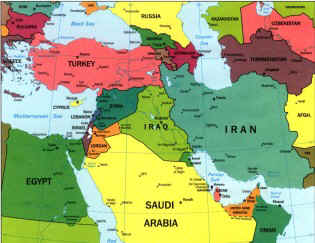Physics Today, June 2000 pp 51 - 52
Toni Feder
Jordan is the first-choice site for a synchrotron light source intended to promote peace and science in the Middle East. That outcome of a vote this past April by representatives from 10 of the project's 11 member states is expected to be ratified in late June at a meeting in Amman, Jordan. However, supporters of opening the facility in Armenia, the backup site, continue to campaign for a fresh vote.
Envisioned as a topnotch international facility, SESAME (Synchrotron-light for Experimental Science and Applications in the Middle East) will be an upgraded reincarnation of BESSY I, a synchrotron donated by Germany. Science programs are being planned in, among other fields, biology, physics, materials science, environmental science, and archaeology. (See Physics Today, August 1999, page 54, and February 2000, page 52.)
 At all levels, we are highly committed to this project," says Khaled Toukan, president of Jordan's Al-Balqa' Applied University and a member of the SESAME council. "We want it to be a success, because we want our country to become a center of science in this region, and an active member of international science." Jordan's King Abdullah II has pledged $1 million a year for five years. Toukan adds that Jordan "has already launched a political and diplomatic campaign to persuade other Arab countries to join SESAME, starting with the Arab Gulf states."
At all levels, we are highly committed to this project," says Khaled Toukan, president of Jordan's Al-Balqa' Applied University and a member of the SESAME council. "We want it to be a success, because we want our country to become a center of science in this region, and an active member of international science." Jordan's King Abdullah II has pledged $1 million a year for five years. Toukan adds that Jordan "has already launched a political and diplomatic campaign to persuade other Arab countries to join SESAME, starting with the Arab Gulf states."
Of the seven bids to host SESAME, Jordan's was favored because of location. The potential sites could be easily reached by Israeli and Palestinian scientists, whose participation is key if SESAME is to help improve relations in the region. Siting SESAME in Jordan, says Joel Sussman, a structural biologist at Israel's Weizmann Institute of Science, "would be superb for us -- we could throw our samples in the back of a van, and be there in two or three hours." The Palestinian Authority, whose bid to host SESAME was defeated, would also have been an excellent choice, he adds.
At least one of the losers in the contest hasn't given up yet. In terms of technical know-how and existing infrastructure, "Armenia's [site] proposal was and still is the only realistic one," insists Varduhi Asaturian, a physicist who represents Armenia at the United Nations Educational, Scientific and Cultural Organization (UNESCO), which is acting as midwife to the project. Armenia's distance from the Middle East conflict worked against siting SESAME there -- but supporters note that the facility could promote good relations among other traditionally hostile neighbors. The Yerevan Physics Institute could house SESAME, and the synchrotron could be readied for $10 million less and two years sooner than elsewhere, Asaturian claims. In addition, Armenia has 350 or so scientists, engineers, and machinists who could work on the synchrotron -- a team of them is helping dismantle BESSY I.
Americans of Armenian descent are lobbying the US government to support siting SESAME in Armenia. And Jirair Hovnanian, a businessman who is heading up the US campaign, has written to UNESCO Director General Koichiro Matsuura, requesting that he revisit the SESAME decision and make a "fair and impartial recommendation." Money for the project could be raised in Armenian diaspora communities, Asaturian and Hovnanian say. At press time, though, the Armenian campaign had yielded no results.
Additional money must still be raised for SESAME. Estimates start at about $65 million for moving, rebuilding, and upgrading BESSY I, constructing associated labs, and operating the facility for five years. Planners hope to raise funds from SESAME member countries as well as from other sources, including Europe, the US, and Japan. "The various problems have to be solved one after the other," says SESAME interim chair and former CERN director Herwig Schopper. "In order to be able to discuss the funding and approach possible sponsors, the site decision had to be taken first."
Toni Feder

